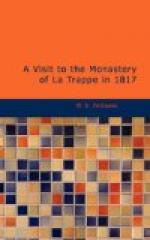The church is one of the finest specimens of Gothic architecture I have seen in France. The towers are of open fretwork, and in excellent preservation. More cheerful scenes of exuberant fertility are nowhere to be met with than along the banks of the river, and in the country surrounding the town.
From Orleans to Etampes, there is a plain of eighteen leagues in extent, the whole of which was covered with one entire tract of corn and vines; not an intervening hill or hillock; and the scene was doubly interesting from the harvest carrying on in every direction as I traversed it.
Leaving Etampes, I passed through the beautiful villages of Sceaux, Bourg-la-Reine, and Fontenay-aux-Roses; the latter still contains the ruins of the Palace of Colbert, the celebrated minister of Louis XIV.
The village of Fontenay-aux-Roses, is situated in a valley six miles from Paris, and takes its name from the culture of roses, which cover large tracts of ground. The proprietors sell the flowers to the distillers for making rose water and essences, and the flower market is supplied with the choicest bouquets; it is likewise celebrated for its produce of the finest strawberries and peaches.
The beauty of its situation, and the association of its name with the sweetest of flowers, has attracted many of the wealthy inhabitants of the metropolis to reside in its vicinity, where they have summer houses; among them is the Maire de Fontenay, Monsieur Ledru, whose history is singular and interesting.
His father, who was very wealthy, and a great miser, sent for him one morning, at the time he had just attained his eighteenth year, and said to him: “I began life at your age with half a crown; there is one for you—go, and be as fortunate as I have been;”—saying which, he turned him out of the house, and shut the door in his face.
Undismayed at such unexpected and unnatural conduct on the part of his parent, whom he had never offended, the youth sought the advice and assistance of a friend, by whose opinion he applied himself to the study of medicine. After an indefatigable study at the Hotel Dieu, he became celebrated in his profession, and had the good fortune to be employed by a lady of great wealth, whose life he saved. Out of gratitude, she proposed to become his wife, and to settle upon him an income of fifty thousand livres, that he might give up his medical pursuits; which, having accepted, he rewarded her by an attention and kindness suitable to the noble generosity of her conduct.
The revolution soon after occurred, and in the general wreck of property she lost all her fortune, it having been invested, either in the funds, or public securities. It then became the turn of Mons. Ledru to support his wife, by renewing the practice of his profession, which soon placed them again in affluent circumstances.




